|
|
||
* You can search this page for a specific year or person by using the combination of the keys Ctrl F on your keyboard.
![]()
1860
| The ill-fated Burke and Wills journey of exploration,
which crossed the continent from south to north, left Melbourne on 20th
August. The expedition had substantial German connections. When ideas for
an expedition were first being discussed, Ferdinand Mueller (Australia's
greatest botanist of the 19th century) thought it should search for traces
of the lost explorer Ludwig Leichhardt. A Prussian adventurer, Gustav von
Tempsky, was nearly chosen as expedition leader. The Irishman who won that
job, Robert O'Hara Burke, had served in the Austrian Army for seven years
and spoke fluent German (though he left the Army in less than honourable
circumstances). William Wills received a place in the expedition through
the support of Georg Neumayer, Director of the Melbourne Observatory. The
three Germans on the expedition were: Hermann Beckler the expedition doctor
and botanical collector, Wilhelm Brahe and Ludwig Becker, who was the official
artist, naturalist and geologist. More about Germans and the Burke & Wills Expedition... |
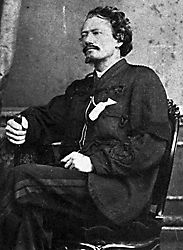 Gustavus Ferdinand von Tempsky (1828-1868). Alexander Turnbull Library, National Library of New Zealand, Te Puna Matauranga o Aotearoa |
During the expedition Becker died of scurvy and dysentery on 28th April 1861
at Bulloo 13 km south of Coopers Creek. The watercolours and drawings he produced
during the expedition are some of the most evocative and beautiful landscapes
of the Australian desert ever made. Unlike others who saw the desert as an enemy,
he was fascinated by it and used experimental techniques (partly forced by the
circumstances he was in) to capture the unique light effects.
More about Ludwig Becker..., incl. his cartoon-strip/song
about a German migrant.
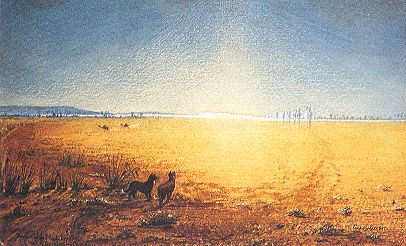 |
Becker's watercolour "Border of the Mud-Desert
near Desolation Camp", 1861. His companions, however, called this camp
Rat Point (near Torowotto in the north-west corner of NSW, 300 km south
of Cooper's Creek). (La Trobe Australian Manuscripts Collection, State Library of Victoria) |
1861
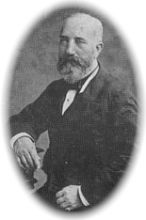 The
Queensland government appointed Johann Christian
Heußler (>>), a German businessman in Brisbane,
as immigration agent for continental Europe. Queensland had become a separate
colony two years earlier and was keen to attract German settlers who would open
up new areas. In order to compete with other Australian colonies such as SA
and Victoria that were already attractive to German settlers, Queensland offered
subsidised transport from Germany to the colony. Heußler went to Germany
and his system was so successful that by 1879 over 17,000 German-speakers had
settled in Queensland. Most of them were farmers and agricultural labourers
from the poor regions of Prussia, Pomerania, Silesia and Württemberg, and the
majority moved to rural areas of the colony. Large numbers settled in the Rosewood,
Fassifern, Lockyer and Darling Downs regions, and later in Mackay, Bundaberg
and Maryborough. The Germans settled in some districts whose terrain and vegetation
had been rejected by British settlers as being too difficult.
The
Queensland government appointed Johann Christian
Heußler (>>), a German businessman in Brisbane,
as immigration agent for continental Europe. Queensland had become a separate
colony two years earlier and was keen to attract German settlers who would open
up new areas. In order to compete with other Australian colonies such as SA
and Victoria that were already attractive to German settlers, Queensland offered
subsidised transport from Germany to the colony. Heußler went to Germany
and his system was so successful that by 1879 over 17,000 German-speakers had
settled in Queensland. Most of them were farmers and agricultural labourers
from the poor regions of Prussia, Pomerania, Silesia and Württemberg, and the
majority moved to rural areas of the colony. Large numbers settled in the Rosewood,
Fassifern, Lockyer and Darling Downs regions, and later in Mackay, Bundaberg
and Maryborough. The Germans settled in some districts whose terrain and vegetation
had been rejected by British settlers as being too difficult.
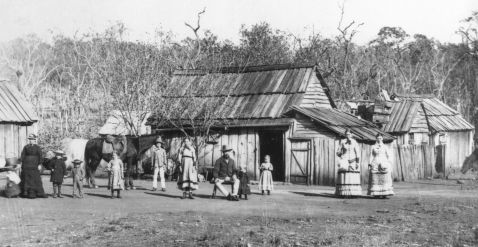
(Above) German settlers at Rosewood (south-west of Brisbane), 1880s. Behind the buildings in the photo can be seen the dense acacia scrub of the area; clearing it was very hard work. (John Oxley Library, neg #60641)
1862
In 1862 at the latest the Austro-Hungarian Empire opened its first consulate, in Sydney. This was upgraded to a General Consulate on the 2nd November 1902. The Empire appointed Honorary Consuls in: Adelaide - approx. 1898; Brisbane in 1909; Melbourne by 1884 at the latest; Perth-Fremantle in 1910; Newcastle - Honorary Vice-Consul in 1914.
1863
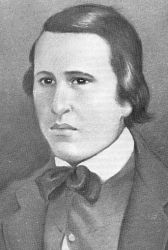
![]() On the night of 2nd August an elderly German stable-hand known as German Charley
encountered the bushrangers (outlaws) Johnny Vane (>>)
and Micky Burke, who were members of Ben Hall's gang. German Charley was in
charge of the stables of Magistrate Thomas Icely, a wealthy pastoralist, at
Coombing Park, near Carcoar, New South Wales (262 km west of Sydney). Ben Hall's
gang valued racehorses as a way of keeping ahead of the police. Vane and Burke,
skilled young horsemen, were stealing two horses, the Arab stallion Comus II
(one of the finest racehorses in the colony) and a grey gelding that was Comus
II's half-brother. German Charley heard noises, challenged them and fired a
shot from a gun. Burke fired back and the bullet hit German Charley in the mouth,
piercing his tongue and then lodging in the thick muscles of his neck. Vane
and Burke escaped on the horses, riding bareback. Fortunately German Charley
made a complete, though slow and painful recovery.
On the night of 2nd August an elderly German stable-hand known as German Charley
encountered the bushrangers (outlaws) Johnny Vane (>>)
and Micky Burke, who were members of Ben Hall's gang. German Charley was in
charge of the stables of Magistrate Thomas Icely, a wealthy pastoralist, at
Coombing Park, near Carcoar, New South Wales (262 km west of Sydney). Ben Hall's
gang valued racehorses as a way of keeping ahead of the police. Vane and Burke,
skilled young horsemen, were stealing two horses, the Arab stallion Comus II
(one of the finest racehorses in the colony) and a grey gelding that was Comus
II's half-brother. German Charley heard noises, challenged them and fired a
shot from a gun. Burke fired back and the bullet hit German Charley in the mouth,
piercing his tongue and then lodging in the thick muscles of his neck. Vane
and Burke escaped on the horses, riding bareback. Fortunately German Charley
made a complete, though slow and painful recovery.
![]() On 7th August the self-taught naturalist Amalie Dietrich arrived in Queensland.
She was a courageous woman who collected plant and animal specimens on her own
in rural areas.
On 7th August the self-taught naturalist Amalie Dietrich arrived in Queensland.
She was a courageous woman who collected plant and animal specimens on her own
in rural areas.
More...
![]() On 26th August a team of police and volunteers tracked the notorious bushranger
(outlaw) Mad Dan Morgan and his accomplice, a man known as "German Bill",
to their bush camp in southern New South Wales, between Urana and Wagga Wagga.
In a shootout during the night, Police Magistrate Henry Baylis of Wagga Wagga
exchanged shots with German Bill. Baylis was injured and German Bill crawled
away under bushes where he died a short time later. Mad Dan Morgan escaped.
Dan Morgan and German Bill first attracted public attention when they raided
Mr Gilbank's Wallandool station in July 1863. They tied up Mr Gilbank and two
stockmen, then stole food, guns, money and watches.
On 26th August a team of police and volunteers tracked the notorious bushranger
(outlaw) Mad Dan Morgan and his accomplice, a man known as "German Bill",
to their bush camp in southern New South Wales, between Urana and Wagga Wagga.
In a shootout during the night, Police Magistrate Henry Baylis of Wagga Wagga
exchanged shots with German Bill. Baylis was injured and German Bill crawled
away under bushes where he died a short time later. Mad Dan Morgan escaped.
Dan Morgan and German Bill first attracted public attention when they raided
Mr Gilbank's Wallandool station in July 1863. They tied up Mr Gilbank and two
stockmen, then stole food, guns, money and watches.
![]() The bushranger Captain Thunderbolt held up a German band on the road in New
South Wales. It ended well for them.
The bushranger Captain Thunderbolt held up a German band on the road in New
South Wales. It ended well for them.
More...
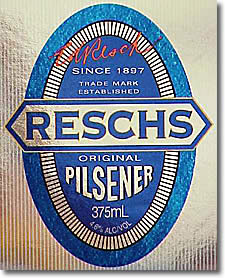
![]() The brothers Edmund, Richard and Emil Resch arrived from Dortmund. In 1879 Edmund
and Richard opened the Lion Brewery in Wilcannia. Business in that hot part
of New South Wales allowed Edmund to buy Alt's Brewery at Waverley in 1897 and
the NSW Lager Bier Brewery (Waverley Brewery) at Redfern in 1900. Resch's Limited
was incorporated in 1906. Edmund was put in an internment camp in World War
One after having been in Australia for 50 years. Resch's Beer was taken over
by Tooths & Co in 1929 and in 1982 Tooths was swallowed by Carlton and United
Breweries, but Resch’s Draught and Resch's Pilsener are still among the popular
beers drunk in New South Wales.
The brothers Edmund, Richard and Emil Resch arrived from Dortmund. In 1879 Edmund
and Richard opened the Lion Brewery in Wilcannia. Business in that hot part
of New South Wales allowed Edmund to buy Alt's Brewery at Waverley in 1897 and
the NSW Lager Bier Brewery (Waverley Brewery) at Redfern in 1900. Resch's Limited
was incorporated in 1906. Edmund was put in an internment camp in World War
One after having been in Australia for 50 years. Resch's Beer was taken over
by Tooths & Co in 1929 and in 1982 Tooths was swallowed by Carlton and United
Breweries, but Resch’s Draught and Resch's Pilsener are still among the popular
beers drunk in New South Wales.
In 1907 the Society of Melbourne Brewers amalgamated to form Carlton and United Breweries. Emil Resch became the first general manager of the newly formed CUB. He installed the first laboratory at the brewery, improving quality control in production and consistency across batches of beer. The brew masters were able to depend less on intuition and judgment and more on laboratory testing and control. When World War One started Emil was given a large payment and told that his services were no longer required at CUB.
1864
At 11 a.m. on 24th October four German passengers on the Yass (New South Wales) mail coach were robbed of £9 by the bushrangers (outlaws) Ben Hall, Johnny Gilbert and John Dunn. One of the Germans had a gun, which Gilbert ordered him not to touch.
1865
German farmers from Victoria's Western District and from South Australia started colonising Victoria's southern Wimmera. Many villages developed, some with German names (Kirchheim, Grünwald, Kornheim), some with Aboriginal names. The Cyclopedia of Victoria, Volume III, An Historical and Commercial Review, published in 1905, says about Murtoa on page 229:
(In 1882) the district was then held almost entirely by Germans, whose superior frugality and simpler ways of life enabled them in many cases to buy out their British and Australian born neighbours.
1866
On 9th October a small party set out from Tanunda (South Australia) to establish
a Lutheran mission station (Lake Killalpaninna) in the salt-lake areas of the
north-east of South Australia.
More...
late-1860s
The first significant German communities in New South Wales were established in the south of the colony around Albury, by people coming from South Australia. They made the long trip of several weeks on their wagons, and the first communities to be established in this way were Gerogery and Jindera in 1867-68.
The Cyclopedia of Victoria, Volume III, An Historical and Commercial Review, published in 1905, says on page 390:
A special feature of the (Albury) district is the large number of Germans who have made it their home, and prove to be one of the most laborious, thrifty, and diligent elements of the population.
1868
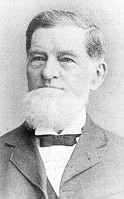 Wilhelm
Alexander Brahe took up his duties as Consul for Prussia in Melbourne. In
1869 he was then appointed Consul for the North German Confederation, and
from 1871 (the year Germany was unified) until 1912 he was Consul for the
German Empire. Before 1868 the port cities of Hamburg and Bremen (and Prussia
also) each had consuls representing them in all of the eastern Australian
capital cities. See Consuls/Diplomats. Wilhelm
Brahe arrived in Melbourne in May 1849, and worked as a lawyer from 1866
onwards (the firm still exists as Gair and Brahe). He was the lawyer for
Melbourne's large German community. "Borussia", the Brahe family
home in Hawthorn, was a centre of German cultural and social life. Brahe's
brother was one of the Germans on the Burke & Wills expedition. Wilhelm
Alexander Brahe took up his duties as Consul for Prussia in Melbourne. In
1869 he was then appointed Consul for the North German Confederation, and
from 1871 (the year Germany was unified) until 1912 he was Consul for the
German Empire. Before 1868 the port cities of Hamburg and Bremen (and Prussia
also) each had consuls representing them in all of the eastern Australian
capital cities. See Consuls/Diplomats. Wilhelm
Brahe arrived in Melbourne in May 1849, and worked as a lawyer from 1866
onwards (the firm still exists as Gair and Brahe). He was the lawyer for
Melbourne's large German community. "Borussia", the Brahe family
home in Hawthorn, was a centre of German cultural and social life. Brahe's
brother was one of the Germans on the Burke & Wills expedition. |
| [Diese Seite auf Deutsch] |
| Top | Back
| Chronology | Issues |
Students | Site Map
| auf Deutsch |
| Primary Sources (in German) | Bibliography
| Search |
German Australia © D. Nutting 2001